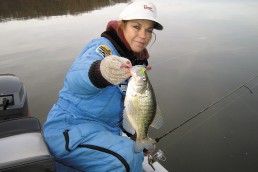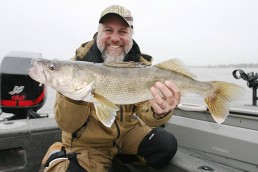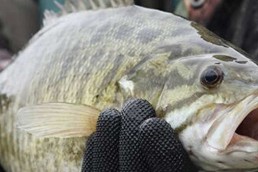Coldwater Bite’s Good!
SHARE THIS POST
When this article comes out, I hope I’m out on Lake Shelbyville fishing for crappies. The way the winter’s gone, this may be another season where Lake Shelbyville doesn’t freeze. Since it hasn’t frozen as I’m writing this, it may not, and if it does, it won’t be frozen for long.
If we have open water we’ll be catching crappies. What area we’re in on the lake determines how we’ll be fishing. Most of the time we’re going to be fishing around wood cover. Because of the erosion problem, there are lay-downs in almost every area of the lake.
If weather conditions are good, we might be able to fish around these lay-downs, much like we did early in the season. We can cast jigs in and around the lay-downs and work it slowly over and around the limbs, getting in where the fish are. This time of year, they’re usually pretty close to the cover and you have to get in there. Sometimes you get snagged, sometimes you get your bait loose and sometimes you have to break off. That’s part of it, but if you watch your line and pay attention to what your jig’s doing, it can be done successfully.
The water’s not so clear here that we can use 6- or 8-pound-test line, so if you can’t jiggle or snap your bait loose, you can frequently pull it loose instead of breaking off.
There are also several areas of rock riprap, like around the bridges and marina areas on the lake. They can be productive because they provide good cover for microorganisms and baitfish. And, the rock is sometimes easier to fish than the lay-downs, but, again you have to watch your line and pay attention because you have to keep bait close to the rocks, but just above so you don’t get snagged.
Are you enjoying this post?
You can be among the first to get the latest info on where to go, what to use and how to use it!
If areas like this and cast and retrieve techniques aren’t working, sometimes you have to resort to using a bobber (float) so you can set your jig at a determined depth and work it slowly around cover, giving fish more time to react to it. You can use a bobber around most types of cover, but when we’re using them—most of the time—we’ll go to one of the areas of standing timber. You may have to experiment with different depths until you find the depth that’s most productive. Sometimes you can catch fish like this when the other techniques aren’t working.
The best way to fish like this is to throw your bait past the tree and reel your bobber up to that tree, and then work it slowly around the trunk until you get a bite. A stationary bobber works best like this because when you’re reeling, the bait stays at the set depth while you’re working it around the tree. If you’re using a slip bobber, the line can slide through the bobber as you’re reeling and raise the jig up near the bobber.
If you go out and try it in the cold, be sure to dress for it so you can enjoy it. Keep trying the different techniques and areas until you find them. It can be very productive in February and March.
Fortunately, if the lake is frozen, we have other options: There are several public ponds around the lake for ice fishing, and if the lake is frozen well, you can also ice fish it.
We also have good fishing below the dam, just off Route 16 at the east edge of the town of Shelbyville. There’s good parking and easy access to the river.
MWO
SHARE THIS POST
Did you enjoy this post?
You can be among the first to get the latest info on where to go, what to use and how to use it!
Mary Satterfield
Lifelong angler Mary Satterfield is a retired professional bass angler, and has she held titles of National and World Champions and Angler of the Year. She’s run the multispecies Eagle Creek Guide Service on Lake Shelbyville since 1989. She may be contacted at: 217-756-3299.



